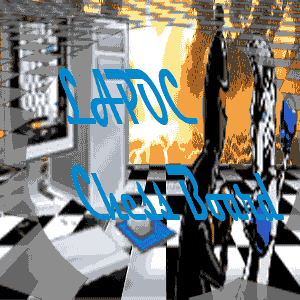| Back to Back Issues Page |
 |
|
LCB, Issue #013 -- When Pawns Face Off in a Showdown June 01, 2012 |
Use the Flowchart Technique to Hammer Your OpponentsLapoc Chess Board, Issue #013 -- When Pawns Face Off in the Rook and Pawn Endgame Showdown learn and play online chess Last month we're switched from purely theoretical mode into conceptual mode. We used the endgame positions stored in your head as building blocks. We saw how every endgame, no matter how complex it may seem, can transpose into one of these building blocks through simplification. We learned how to look at more complicated endgames and recognize what kind of endgames they would evolve into as they simplified. We called this the 'Flowchart Technique'. We learned to convert one type of endgame into another through technique until we reached a building block position that we knew how to play from memory. We're going to stick with the Flowchart Technique. We're also sticking with Rook and Pawn Endgames this month. We'll be doing Rook and Two Pawns vs Rook and One Pawn, Rook and Three Pawns vs Rook and Two Pawns and finally Rook and Four Pawns vs Rook and Three Pawns Endgames. The Pawns will be on the same side of the board in all of these endgames. Pawns on the Same Side of the BoardRook and Pawn Endgames with One Pawn MajorityIn the vast majority of cases, the weaker side benefits from trading pawns in the endgame. Your chances of claiming a draw increase significantly with each pair of pawns you get off the board. This rule of thumb certainly applies to Rook and Pawn Endgames when you're a pawn down, with all of the pawns on the same side of the board. You should also make sure you keep your rook as active as possible. You will always look to place your rook on the same rank as your opponent's rear pawn. This forces the enemy king to hang back and protect it. He can't advance and take a full part in the attack. Trade down to a favorable Rook and Pawn vs Rook endgame where you can slip into the Philidor Position which is an easy draw. Rook and Two Pawns vs Rook and One PawnThese endgames are drawn as long as the stronger side does not have a passed pawn. As the defensive side, you're playing for the Philidor Position if there is no passed pawn. Make sure and get your king in front of the enemy pawns. Get your rook active and constantly harassing the rear enemy pawn. Trade your pawn for one of your opponent's pawns and then set up the water tight Philidor. You also need to be familiar with the Philidor Gone Bad routine and the phenomenon that is Trebuchet. Don't allow your king to get locked out of the battle on some other file or your opponent will have the easy task of either setting up a Lucena Position or forcing your rook into a passive position and winning. Rook and Two Pawns vs Rook and One Pawn Endgame. Rook and Three Pawns vs Rook and Two PawnsThe defending side can also get a draw in these circumstances by trading down favorably in order to simplify into the previous endgame. He must make sure not to allow the enemy pawns from advancing too far up the board. If the three pawns reach the 5th rank side by side they will be too close to their goal to be stopped. The defending pawns must push forward and meet them head on before they get this far. The defenders must not play passively. If the two pawns are isolated they certainly don't want to allow the three connected enemy pawns to enter their half unchallenged. This would result in the defending king being pushed back on his home rank and the defending rook getting stuck their too to prevent back rank mates. Defeat would be inevitable. Rook and Three Pawns vs Rook and Two Pawns Endgame. Rook and Four Pawns vs Rook and Three PawnsFrom this endgame the defender is looking to trade down favorably first to 3 pawns vs 2, then to a 2 pawns vs 1, then to a Rook and Pawn vs Rook where he will set up a Philidor Defense securing the draw. Again he must prevent the stronger side from overwhelming his forces with a rolling pawn mass sweeping up the board. Once those things get going they can be hard to stop without taking fatal casualties. As the two sides start to trade down the pawns, both sides are looking for the sort of trades that would favor them positionally. The stronger side would like to trade in such a way that the enemy pawns get separated and isolated from each other, therefore considerably weakened. The defender would like to keep his pawn chain intact as the two sides get whittled down. In these situations always advance your own pawns as far up the board as you can before the two pawn chains meet. It's important to fight for everything in this battle for space. Also remember to always keep your rook active and tying down the enemy king to his rear pawns. Rook and Four Pawns vs Rook and Three Pawns Endgame. P.S. If you do not have html based email software and you're using a text only system, you may find that the links are only partially highlighted and may not work. If this is the case, simply copy and paste the entire link into the browser and hit Enter. That should get you where you want to go. Comments, ideas, feedback? I'd be stoked to hear from you. Get in touch See you next month. Ken 
|
| Back to Back Issues Page |